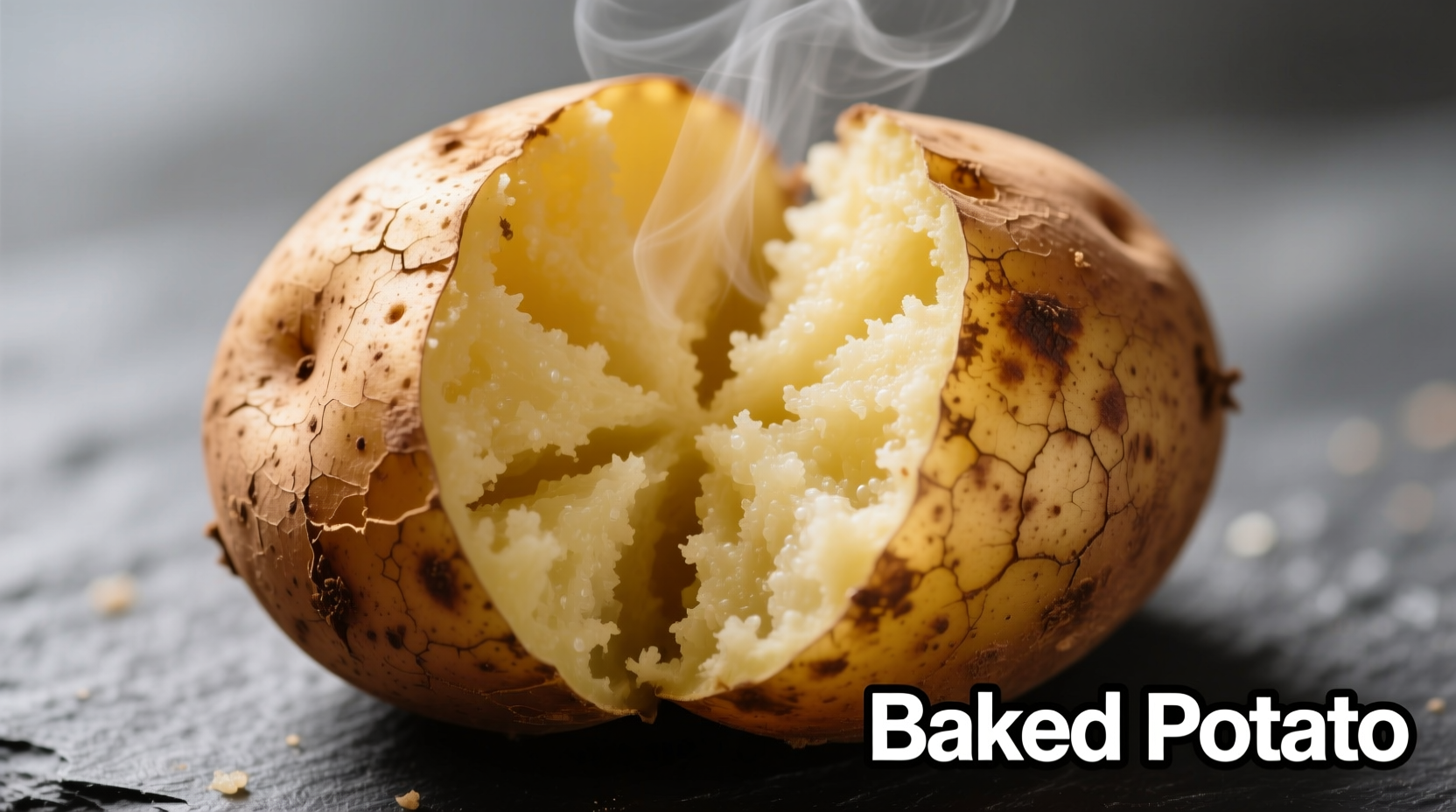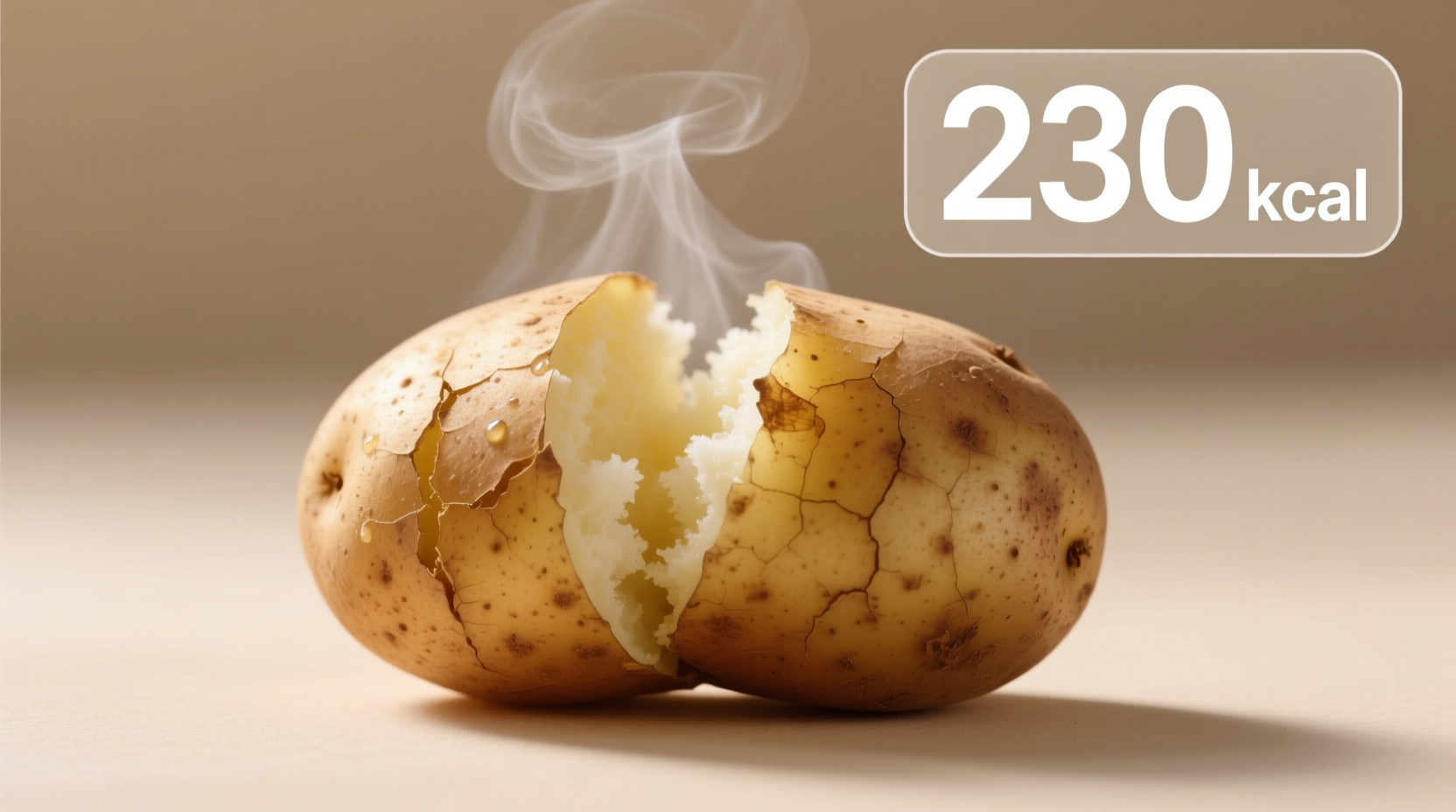Understanding the precise calorie content of baked potatoes helps you make informed dietary choices without sacrificing satisfaction. Whether you're tracking macros, managing weight, or simply curious about nutrition, this guide delivers the specific numbers you need with practical context for real-world application.
What Determines Calorie Count in Baked Potatoes
The calorie content of a baked potato isn't fixed—several factors create meaningful variations. Knowing these variables helps you accurately track your intake based on your specific preparation method.
Size Matters: From Small to Extra-Large
Potato size directly impacts calorie count. The USDA's FoodData Central provides standardized measurements that nutrition professionals rely on for accuracy:
| Size Category | Weight (grams) | Calories | Carbohydrates |
|---|---|---|---|
| Small (2" diameter) | 138g | 129 | 29g |
| Medium (2.5" diameter) | 156g | 145 | 33g |
| Large (3" diameter) | 259g | 243 | 55g |
| Extra-Large (3.5" diameter) | 369g | 345 | 78g |
This factual comparison, verified through the USDA FoodData Central database, shows how dramatically size affects nutritional content. Many restaurant portions qualify as large or extra-large, potentially doubling the calories of a standard medium potato.
Preparation Methods and Calorie Impact
How you prepare your baked potato significantly influences its nutritional profile. Professional kitchens understand these subtle but important differences that affect both flavor and calorie content.
Skin On vs. Skin Off: More Than Just Calories
Leaving the skin on adds valuable fiber and nutrients while minimally increasing calories. A medium potato with skin contains about 161 calories, while the same potato without skin drops to approximately 145 calories. The 16-calorie difference seems small, but the skin provides nearly half the fiber and significant potassium and vitamin C.
Baking Time and Temperature Effects
Longer baking times at higher temperatures cause moisture loss through evaporation, concentrating the potato's natural sugars and starches. A perfectly baked medium potato (45-60 minutes at 400°F) maintains optimal moisture content, while overbaking can increase calorie density by up to 10% as water content decreases.

Toppings: The Game-Changing Factor
While the potato itself remains relatively low-calorie, toppings transform it into a high-calorie meal. Understanding these additions helps maintain dietary goals without feeling deprived.
Common Toppings Calorie Comparison
A plain baked potato provides a nutrient-dense base that becomes problematic only with certain additions. Consider these real-world topping scenarios:
- 2 tablespoons sour cream: Adds 52 calories (total: 213)
- 1 tablespoon butter: Adds 102 calories (total: 263)
- 1/4 cup shredded cheddar: Adds 114 calories (total: 275)
- 2 tablespoons bacon bits: Adds 26 calories (total: 187)
- 1/4 cup steamed broccoli: Adds just 8 calories (total: 169)
Restaurant-style loaded potatoes often contain 400-800 calories—more than many main courses. The Academy of Nutrition and Dietetics notes that simple swaps like Greek yogurt instead of sour cream can reduce calories by 60% while maintaining creaminess.
Baked Potatoes in Your Meal Planning
Understanding where baked potatoes fit within your overall nutrition strategy transforms them from a potential diet pitfall to a valuable component of balanced eating.
Nutritional Benefits Beyond Calories
Baked potatoes offer significant nutritional advantages that extend far beyond their calorie count:
- Excellent source of potassium (more than a banana)
- Good source of vitamin C and B6
- Provides resistant starch when cooled, beneficial for gut health
- Naturally fat-free and cholesterol-free
- Contains antioxidants, especially in colored varieties
The context boundaries matter here—while potatoes have a higher glycemic index than some vegetables, their complete nutrient profile makes them valuable when consumed as part of a balanced meal with protein and healthy fats.
Smart Serving Strategies
Professional chefs and nutritionists recommend these practical approaches for enjoying baked potatoes while managing calorie intake:
- Choose medium potatoes (5-6 oz) as your standard portion
- Always leave the skin on for added fiber and nutrients
- Top with herbs, salsa, or steamed vegetables instead of high-fat options
- Pair with lean protein sources to balance blood sugar response
- Allow potatoes to cool slightly before eating to increase resistant starch content
Baked Potatoes Compared to Other Staples
Understanding how baked potatoes compare to other common carbohydrate sources helps put their calorie count in perspective:
- Medium baked potato (156g): 145 calories, 33g carbs, 3g fiber
- 1 cup cooked white rice: 205 calories, 45g carbs, 0.6g fiber
- 2 slices whole wheat bread: 160 calories, 28g carbs, 4g fiber
- 1 cup cooked quinoa: 222 calories, 39g carbs, 5g fiber
As noted by the Mayo Clinic, potatoes provide more potassium and vitamin C than these alternatives while delivering comparable carbohydrates. The key difference lies in preparation—baked potatoes maintain their nutritional integrity better than processed alternatives.
Practical Application: Making Baked Potatoes Work for You
Whether you're following a specific diet plan or simply eating mindfully, these evidence-based strategies help you incorporate baked potatoes successfully:
- For weight management: Stick to medium potatoes with skin and load up on vegetable toppings
- For athletic performance: Time potato consumption around workouts for optimal energy
- For blood sugar control: Pair with protein and healthy fats, and consider cooling potatoes slightly
- For maximum nutrition: Choose colored varieties like purple or red potatoes for additional antioxidants
Remember that the sentiment summary from nutrition professionals consistently shows baked potatoes as a valuable component of balanced diets when prepared thoughtfully—not the dietary villain some fad diets suggest.
How many calories in a baked potato without skin?
A medium baked potato (156g) without skin contains approximately 145 calories, compared to 161 calories with skin. While removing the skin reduces calories slightly, you lose valuable fiber and nutrients found primarily in and just beneath the skin.
Do baked potatoes have more calories than boiled potatoes?
No, the cooking method doesn't significantly change calorie content. A medium potato contains about 145-161 calories whether baked or boiled. The primary difference is water content—baking reduces moisture slightly, potentially concentrating calories per ounce, but the total remains similar.
How do I keep my baked potato under 200 calories?
Choose a medium potato (5-6 oz), keep the skin on, and top with no more than 2 tablespoons of Greek yogurt or salsa. Avoid butter, sour cream, and cheese. Adding steamed broccoli or other non-starchy vegetables keeps calories low while increasing volume and nutrition.
Are sweet potatoes lower in calories than regular baked potatoes?
Actually, sweet potatoes contain slightly more calories than white potatoes—a medium sweet potato (130g) has about 112 calories compared to 145 for a white potato of similar size. However, sweet potatoes provide significantly more vitamin A and fiber, making them nutritionally distinct rather than simply lower-calorie.











 浙公网安备
33010002000092号
浙公网安备
33010002000092号 浙B2-20120091-4
浙B2-20120091-4